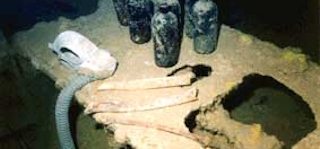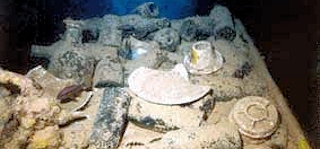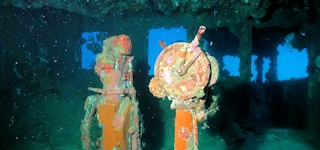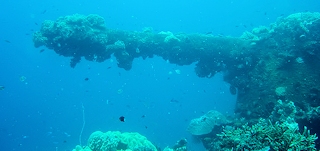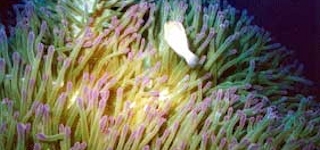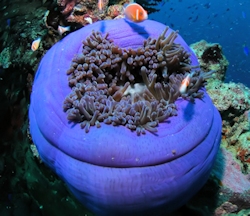Shinkoku Maru
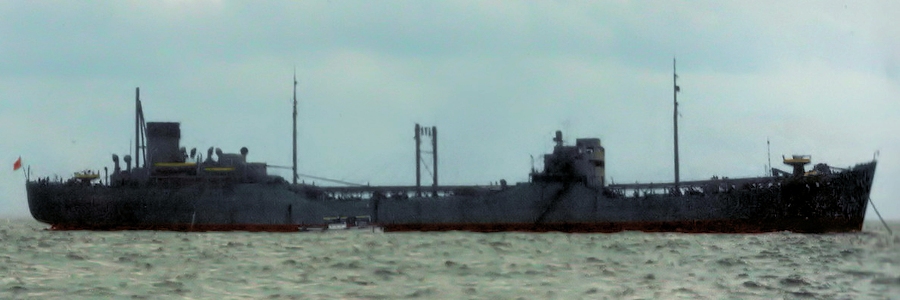
The second largest wreck in Chuuk Lagoon. The Shinkoku Maru was built in 1939 by Kawashi Jyuko Co. of Kobe for Kobe Sanbashi K.K. (Kobe Pier Co. Ltd). It was 150 metres long and 20 metres wide and was requisitioned by the Japanese Navy in 1941, four weeks before Pearl Harbour.
The Shinkoku Maru was one of eight oilers that refuelled the Japanese fleet that attacked Pearl Harbour. Later she participated in the attack on Ceylon and then performed general re-supply duties. On 17 August 1942 she was torpedoed by a US submarine but only received minor damage. The USS Peto torpedoed the Shinkoku on 7 July 1943 but it was repaired at Singapore and was operational again by 15 August.
The Shinkoku arrived in Chuuk prior to the strikes of 17-18 February 1944 and is believed to have been hit amidships by one bomb dropped by the Dauntless dive bombers of the carrier USS Yorktown CV10 on 17 February 1944. The next morning, six torpedoes were fired at the ship by planes from the USS Bunker Hill CV17 but they all missed. Later the same day, Grumman Avengers from an unknown aircraft carrier sunk the Shinkoku Maru in a torpedo attack that opened a large hole on the port side and flooded the engine room.
Wreck Description
Sitting upright on the sandy bottom, the Shinkoku is a wreck that can be dived by anyone, its depth ranges from 11 metres on the bridge down to 39 metres near the propeller.
The bow gun is quite impressive and very overgrown with coral. There is loads on assorted debris scattered all over the deck. There is also a large white tiled communal bath inside.
Lying in relatively shallow water, it is one of the best dives in Chuuk for access and ease of diving. Dive boats generally hook up to the forecastle and as you descend the deck of the wreck is immediately visible. A short swim forward brings you to the bow gun located at about 15m. The coral growth is amazing on this wreck because of its relative shallowness. The bow gun looks as though someone has draped the growth over it like a table cloth, and it hangs down as if frozen in time. There is a rubber gas mast positioned at the foot of the gun which adds to the overall surrealness.
Swimming aft towards the bridge structure you will pass the holds which are empty. About have way back there are two large anemones absolutely swarming with pink anemone fish. As you pass the forecastle you swim through thousands of Blue Chromis. Arriving at the bridge you enter the small hatchway. The first thing you notice is the size of the internals and how empty they are. Most of these wrecks had wooden decks which were either burnt when the wreck was bombed, or have since rotted away.
As you exit the water after 55mins you feel a sense of loss at having to leave.
Dr Shane Currie
You have to be careful here not to stir up the sediment on floor or else you will be enveloped in a cloud of red silt. There is also a total lack of growth inside the wrecks, because there is no light. The only colour is the redness of rusting steel superstructure when your light beam hits it. Moving through the bridge structure you see the scattered wreckage of tables, bottles etc and as you approach the exit you stop to look into the bathroom, complete with white porcelain urinals and a large tiled communal bath. As you exit the superstructure you are again swamped with coral and fish and immediately come across another large anemone complete with its family of Orange-fin Anemone Fish. You continue aft passing through 20m and past the large mast reaching towards the surface, totally encrusted in coral.
After a long swim, passing over heaps of assorted debris scattered on the deck you reach the engine room superstructure and enter the darkness within. Proceeding through the walkways you come to the engine room and stand on the catwalk looking down at the tops of the huge pistons. You swim down for a closer look. There is very little damage here and most of the gauges are still intact displaying their last readings.
You’re now at 30m.
After a few minutes you exit the engine room and continue onto the stern of the ship. Here you find an engine telegraph and pretend to order full steam ahead. You’ve now swum the entire length of the ship and turn around and make your way back to the forecastle to make your ascent. The safety stops on the forecastle are possibly the best fish experience in Chuuk Lagoon, with the Sankisan Maru perhaps the only ship better. The shear volume of small fish that inhabit these structures is beyond description. They are literally hypnotizing to sit with. They move with the ebb and flow of the surface waves – small as they are – and occasionally dart into their hiding holes when they spot something they don’t like, coming out again soon after to continue their dance.
The hard and soft corals are a rainbow of colours. Being only 5m below the surface the natural light is enough to light them up. You could spend hours closely inspecting each of the corals looking for the small shrimp, crabs, worms etc that inhabit them. All the while schools of batfish circle in mid water keeping a close eye on you.
As you exit the water after 55mins you feel a sense of loss at having to leave.
